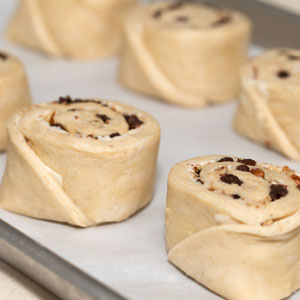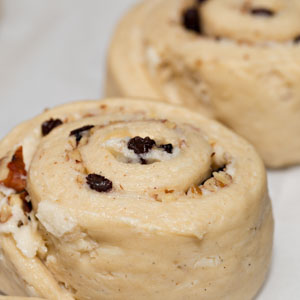Danish Schnecken

introduction
Schnecken, as their shape suggests, represent snails. Schnecken are made by rolling raw ripened Danish dough into a thin square sheet, then, in our variation, spreading the surface with a fluffy butter and sugar concoction called remonce. Currants and pecans are strewn lavishly on top, and the dough is rolled into a long cylinder like a carpet. Danes deploy remonce in nearly all Danish fillings owing to the cushion of moisture, flavor, and grip it offers the already extravagant dough and filling. Cut into thick pinwheel rounds, schnecken are set to proof. Once baked, schnecken are moist within, crisp without, and carry the flavors of chopped pecans and rum-doused currants into the flaky folds of a well-fermented, high-performance pastry.
Baking Notes
If you do not have more than two sheet pans, when proofing the schnecken, loosely cover them with plastic wrap, making sure their sides covered, then lay a kitchen towel on top.
An electric knife will advance cutting the rounds to status “easy.”
Reheat leftovers in a moderate oven.
equipment mise en place
To prepare the currants and pecans, you will need a digital kitchen scale, two small bowls, and a small skillet.
To make the remonce, you will need a medium bowl, a handheld mixer, a rubber spatula.
To roll, shape, and bake the Danish, you will need a bench knife, a rimless cookie sheet, parchment paper, a couche or 3-foot-square heavy canvas cloth, a rolling pin, a ruler, four half sheet pans, an empty baking dish or pie plate, a pizza stone, a teakettle, a metal bench knife or pizza cutter, a small offset spatula, an electric knife or sharp bread knife, two wire racks, and a wide metal spatula.
To make and apply the glaze, you will need a digital kitchen scale, a fine conical sieve, a small whisk, and a pastry brush.
-
for the currants and pecans:
-
2ounces dark rum
-
3.2ounces currants
-
4ounces pecans
-
-
for the remonce:
-
3.5ounces unsalted European-style butter, room temperature
-
3.5ounces superfine sugar
-
0.3
-
½teaspoon vanilla extract
-
⅛teaspoon fine sea salt
-
-
-
1recipe Classic Danish Pastry Dough
-
Anson Mills French Mediterranean White Bread Flour or Colonial Style Fine Cloth-Bolted Pastry Flour, for dusting
-
-
for the glaze:
-
2ounces confectioners’ sugar, sifted
-
0.5ounce water
-
-
The night before you plan to bake, prepare the currants and pecans: In a small bowl, combine the currants and rum in a small bowl. Cover and set aside. In a small skillet, toast the pecans over medium-low heat, shaking the pan frequently, until they become fragrant but before any visible browning is evident, about 10 minutes. Transfer to a small bowl, let cool, then chop finely. Return to the bowl, cover, and set aside.
-
The day of baking, make the remonce: Turn the butter into a medium mixing bowl and beat it with a handheld mixer on medium-high speed until light and fluffy, about 2 minutes, scraping down the bowl as needed. Add the sugar and continue to beat until the mixture is once again fluffy and aerated, about 2 minutes longer, pausing once to scrape down the bowl. Add the flour, vanilla and salt and beat until incorporated, about 15 seconds. Scrape down the bowl, cover with plastic wrap, and set aside.
-
Roll out the dough: Remove the dough from the refrigerator and cut it in half crosswise with a bench knife; each half should weight 18-plus ounces. Rewrap each half, return one piece to the refrigerator, and allow the other piece to rest at room temperature for 15 minutes.
-
Line a rimless cookie sheet with parchment paper. Lay a couche or 3-foot-square heavy canvas cloth on the counter. Dust the couche with flour, unwrap the dough, set it on the couche, and lightly flour the dough. Roll it into a 10-inch square. Slide the dough onto the prepared cookie sheet, cover it lightly with plastic wrap, and refrigerate it for 30 minutes to allow it to relax.
-
While the dough is resting, line 2 half sheet pans with parchment paper and set them, along with 2 additional half sheet pans, aside. Adjust the oven racks to the lowest and upper-middle positions. Set an empty baking dish or pie plate on the lower rack and a pizza stone on the upper-middle rack. Fill a teakettle with water and set it on the stove, but don’t turn on the burner. Drain the currants and dry them on paper towels.
-
Lightly flour the couche. Unwrap the dough, set it on top, and lightly flour the dough. Roll out the dough to a 12-inch square. Using a ruler and a bench knife or pizza cutter, trim the edges to make a tidy square.
-
Using a small offset spatula, spread half of the remonce in a smooth, even layer on the dough, leaving a 1-inch wide border across the far edge of the dough. Sprinkle evenly with half of the currants and half of the pecans (fig. 7.1). Starting at edge nearest you, roll the dough jelly roll–style to form a log 12 inches long and 2 inches in diameter (fig. 7.2). Roll the log so that the seam is on the bottom. Using an electric knife or a sharp serrated knife, cut the log into ten sections of even thickness. One at a time, place the pieces cut side-up on one of the parchment-lined sheet pans, tucking the free end underneath (fig. 7.3); space the pieces evenly apart. Flatten each one lightly with the palm of your hand. Invert one of the unlined half sheet pans over the filled pan, forming a proofing box, and let the schnecken rise until they are nearly doubled in size, about 2 hours (fig. 7.4). About 30 minutes into the rising, repeat the process with the remaining dough, remonce, currants, and pecans.
-
After the first batch of schnecken have proofed for about 1 hour, heat the oven to 400 degrees. After about 1¾ hours of proofing, bring the kettle of water to a boil. About 5 minutes before baking, pour 1 inch of the boiling water into the empty dish on the lower oven rack.
-
Slide the first batch of schnecken onto the pizza stone and immediately lower the oven temperature to 375 degrees. Bake until golden brown and well-risen, about 20 minutes, turning the sheet pan front to back halfway through.
-
Set the sheet pan on a wire rack and let cool for 5 minutes (fig. 10.1). Increase the oven temperature to 400 degrees and return the kettle of water to a boil. Using a wide metal spatula, transfer the schnecken to the wire rack, then set the rack in the now-empty sheet pan.
-
While the schnecken are still hot, make and apply the glaze: In a small bowl, whisk together the confectioner’s sugar and water whisk until smooth; the glaze should have the consistency of raw egg white. Brush the glaze over the still-warm schnecken (fig. 11.1). Let cool for 5 to 10 minutes, then serve warm or allow to cool completely and serve, but for optimal enjoyment, consume the schnecken within a few hours of baking.
-
Bake the second batch of schnecken as you did the first batch, pouring additional water in the dish on the lower oven rack about 5 minutes before baking.
-
-
7.1

-
7.2

-
7.3

-
7.4

-
-
-
10.1

-
-
-
11.1

-